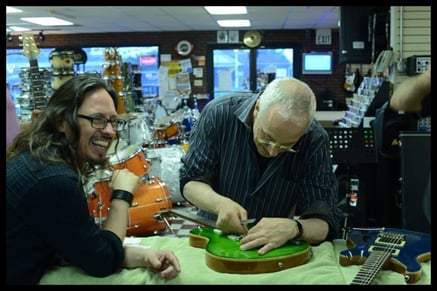Great tone. Where does it come from? Your hands? Your strings? The pick you use or don’t, pickups, pots, wires, capacitors, species of tone-woods, body-carve, action, cables, pedals, signal-chain, pre-amp tubes, power-tubes, tube-bias, circuit-design, speakers, cabinet construction, configuration, design, materials…what did I leave out? Whatever it is, the answer is: all of the above.
I’m a guitar-player and like most of us, I can be overly-sentimental about the gear I use and the guitars I play but for me, when everything else is stripped away the love for playing still starts with what caught my attention as a pre-teen, the guitar itself. My modest collection (compared to some) is utilitarian in nature: I use them all for various gigs, sessions and projects and each one is necessary to have for reasons we guitar players understand and our wives and girlfriends pretend they don’t. If you’ve read this far that’s because we’re members of the same tribe so, hail fellow well-met and how you doin’?
I’m going to brag about one of the guitars I own; not my Les Paul, the grand piano of electric guitars or one of my beloved Stratocasters but my desert-island guitar: the one if I could only have one, could passably get me through any situation.
My PRS Blue Mateo 2003 Custom 24 (and my 2012 Stripped 58)
with Paul and the Guitar Gang at Moore Music

There are many other Custom 24 model guitars out there but this one is mine. It came with the old 5-way rotary switch which didn’t work on stage for me with sweaty hands so I ordered the push-pull, 3-way, McCarty-style pick-up selector drop-in mod and all was right. I get a lot of mileage from the coil-tapped neck position allowing me to get Texas-blues style tone and response ala Stevie and Jimi. In two moves I can be full humbucking in the bridge when maximum output and shreddage is called for. Whenever we do a wood-library run for Moore Music (when we hand-select woods, colors and spec out Custom 24’s at the factory) we always go with this option.
I first met Paul Smith when he visited Moore Music in 2013 and was immediately impressed with someone who was continually honing his craft in the pursuit of perfection. After he signed the back of my Custom 24’s headstock,
He told me, “There’s something wrong with your Stripped ’58. When we look at the saddles under a microscope we found the strings aren’t in full contact along the string slot. Do you have a nut file?” So, Paul Reed Smith worked on my Paul Reed Smith.

On another visit, to Moore Music I got to talking with Jim Cullen, the national sales manager and we were discussing the 5-way blade switch on Custom 24’s, why we do our wood-library runs with McCarty-style switching and the unavoidable but tolerable volume drop when you coil-tap a humbucking pick-up. In one of those moments of synergy, like, when your band organically stumbles on a riff or a groove and there’s a holy sh-t moment, the Idea was floated: what about 408 electronics on a Custom 24? Jim said, “Let me run it by Paul and see what he thinks of it.”
So, that’s it. The idea for the PRS Custom 24-08 originated right here at the PRS Experience at Moore Music showroom floor, August 2015. I have no doubt it’ll catch on, especially when you set it up to switch from coil-tapped neck position to humbucking bridge in one deft sweep of the 3-way switch. Check me out playing it through my personal amp: a Mesa Boogie Stiletto Ace 2X12 combo. Huh, what do you know? I have a story to tell about the creation of that amplifier. There’s an idea for my next blog.


